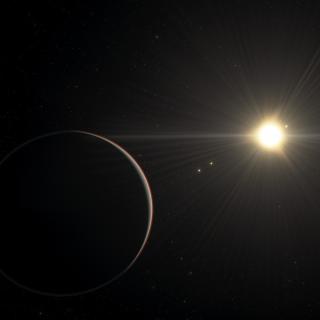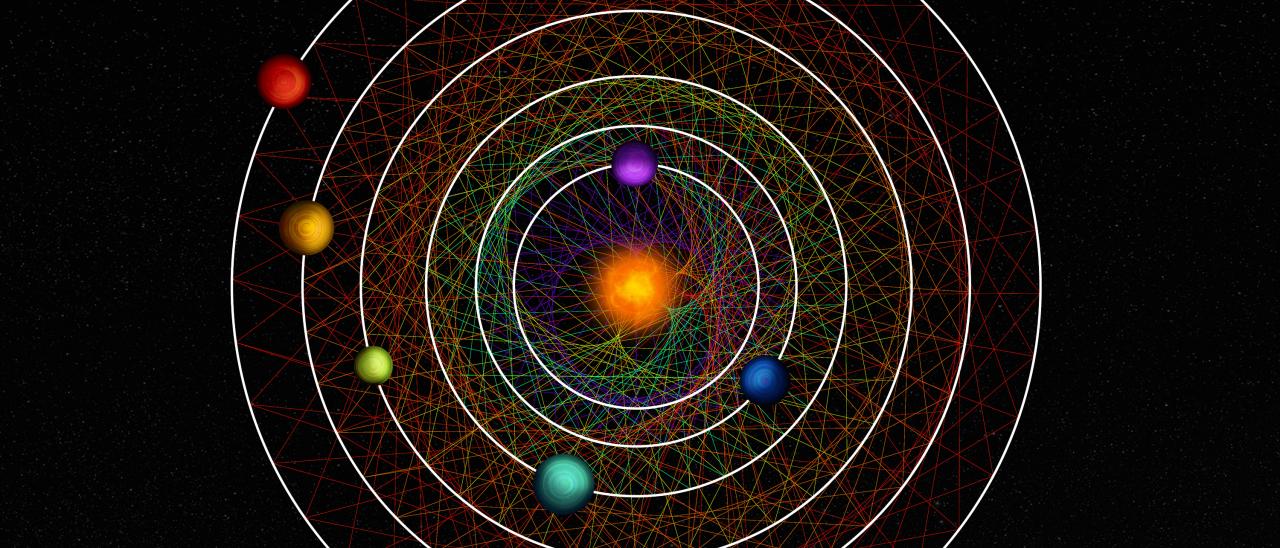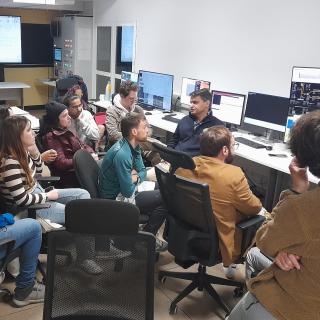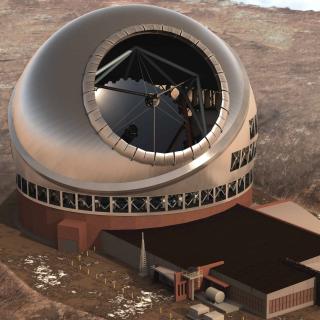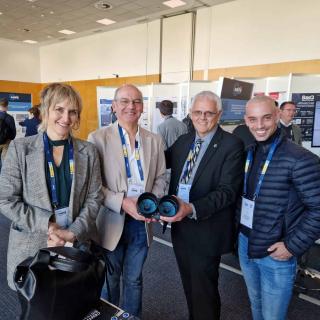Tracing a link between two neighbour planet at regular time interval along their orbits, creates a pattern unique to each couple. The six planets of the HD110067 system create together a mesmerising geometric pattern due to their resonance-chain. Credit: © CC BY-NC-SA 4.0, Thibaut Roger/NCCR PlanetS
An international collaboration, with participation by the Instituto de Astrofísica de Canarias (IAC), has found a system of six exoplanets orbiting a central star with a precise rhythm.This phenomenon, known as orbital resonance, is common during the starting phase of planet formation, but it is exceptional to find a system with such a large set of planets which conserves this kind of gravitational synchronism. This finding shows that the system has not undergone major changes during its six billion year history, so that it gives an unusual view of the formation and evolution of planets. The results of this study are published in Nature magazine.
Thanks to a collaboration between the consortium of NASA’s TESS satellite (Transiting Exoplanet Survey Satellite) and the CHEOPS satellite (CHaracterising ExOPlanets Satellite) of the European Space Agency (ESA), an international team of scientists has discovered a system made up of six planets which orbit the star HD 110067. This star is some 100 light years away towards the northern constellation Com Berenices; it is smaller and cooler than the Sun.
The planets around HD110067 are of the type called sub-Neptunes, planets somewhat smaller than Neptune. Even though this makes it an odd family, its most distinctive feature is its peculiar set of resonances. This phenomenon occurs when the planets orbit their home star in an ideal harmony, performing an orbital dance which is repeated precisely.
In this case, the planet nearest to the star completes three orbits for each two of the next planet (this is called a 3:2 resonance), a patttern which is repeated among the four inner planets. But among the outermost planets there is a repeated pattern of four orbits for every three of the next planet outward (a 4:3 resonance). A result of this chain of resonances is that when the innermost planet completes six orbits, the outermost completes just one.
On the trail of a mysterious family of planets
The discovery of this planetary system reads almost like a detective novel. The first hints of the presence of exoplanets arose after the observations by NASA’s TESS satellite, which monitors the apparent dips in the light, produced by transits of planets when they pass in front of their stars. The scientists identified two planets, which turned out to be the interior planets, with orbital periods of 9 days for the innermost, and 14 days for the next one.
Afterwards, data from the CHEOPS satellite identified a third planet with an orbital period of some 20 days, and it was clear that the orbits of the three planets obeyed 3:2 resonances. The team then considered the possibility that there might be other planets in the chain of resonances. “CHEOPS offered us a resonant configuration which allowed us to predict all of the remaining periods” explains Rafael Luque, a researcher at the University of Chicago who led the study.
The study, combining observational data with mathematical models of gravitational interactions, predicted the existence of the three outer planets with orbital periods of 31, 41, and 55 days. Follow-up observations with CHEOPS, and a reanalysis of the TESS data confirmed that these planets were just where the resonance chain had predicted.
A key discovery for the future
Systems of planets tend to be in resonance during their early formation stages, but are easily perturbed. Collisions between planets, mergers or disruptions, the presence of giant planets like Jupiter, or even passing close to another star, can alter the orbital equilibrium. As a result the great majority (99%) of multi-planetary systems are not in resonance, although they might have been at one time.
“Among the more than 5,000 planets found orbiting stars other than the Sun, resonances are not rare, and neither are systems with several planets. However it is extremely uncommon to find systems in which the resonances are in a chain as long as that formed by six planets. This shows that the system has not undergone major changes since its formation over a billion years ago” says Enric Pallé, a researcher at the IAC and a coauthor of the article.
Another important aspect of the finding is that HD110067 is the brightest star known with four or more planets. As all of these planets are smaller than Neptune, and probably have extended atmospheres of hydrogen and helium, they are ideal candidates for new studies which will enable us to determine their chemical composition and the other properties of their atmospheres.
"The planets of the HD110067 system seem to have low masses, which suggests that they may be rich in gas or water. Future observations of these planetary atmospheres, for example with the James Webb Space Telescoope (JWST), could show us if the planets have rocky internal structures, or are rich in water” points out Pallé.
This discovery has counted with an important Spanish participation, especially in the measurements of the mass of four of these exoplanets performed with the spectrographs CARMENES (Calar Alto high-Resolution search for M dwarfs with Exoearths with Near-infrared and optical Échelle Spectrographs), at Calar Alto Observatory (CAHA), and HARPS-N (High Accuracy Radial velocity Planet Searcher), at Roque de los Muchachos Observatory (ORM). Hundreds of measurements were needed to disentangle the signals from each of the planets in this system. The MuSCAT2 instrument (Multicolour Simultaneous Camera for studying Atmospheres of Transiting exoplanets), installed on the Carlos Sánchez Telescope (TCS) at the Teide Observatory, has also been used for the detection of transits.
As well as Enric Pallé, other members of the IAC who partipated in this work: Ilaria Carleo, Jaume Orell Miquel, Roi Alonso, Hans Deeg, Emma Esparza Borges, Felipe Murgas and Hannu Parviainen.
Article: R. Luque et al. “A resonant sextuplet of sub-Neptunes transiting the bright star HD 110067”, Nature, 2023. DOI: 10.1038/s41586-023-06692-3
Contact at the IAC:
Enric Pallé, epalle [at] iac.es (epalle[at]iac[dot]es)
